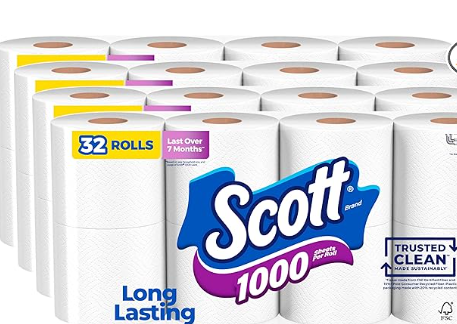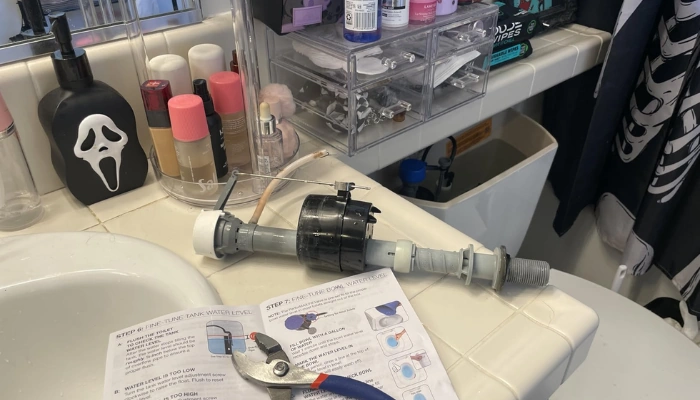Calcium buildup, also known as limescale, is a common problem in toilets, especially in homes with hard water. Over time, minerals like calcium and magnesium settle on the porcelain surface, forming stubborn white or yellowish rings that are difficult to remove with regular cleaning. Not only do these deposits make your toilet look dirty, but they can also reduce flushing efficiency and create areas where bacteria can grow.
In this guide, you will learn practical, step-by-step methods to remove calcium buildup from your toilet bowl, from simple natural solutions like vinegar and baking soda to stronger options such as pumice stones and commercial cleaners. You will also discover preventive tips to keep your toilet sparkling clean and minimize future limescale formation. By following these methods, even the toughest calcium deposits can be effectively eliminated, restoring both the appearance and performance of your toilet.

ACTIVE Automatic Toilet Bowl Cleaner Tablets Blue Gel Toilet Tank Cleaners
Active Automatic Toilet Bowl Cleaner Tablets keep your toilet clean and fresh with minimal effort. These blue gel tablets release cleaning agents in the tank to remove hard water rings, stains, and odors while being septic-safe. Each tablet provides long-lasting cleaning and a fresh scent, making toilet maintenance quick and easy.
Check PriceWhat Is Calcium or Limescale Buildup in a Toilet
Calcium buildup, also known as limescale, is a chalky white, yellow, or brown residue that forms when hard water evaporates. Hard water contains high levels of dissolved minerals, primarily calcium and magnesium. When water sits in the toilet bowl or flows through the rim jets and evaporates, these minerals are left behind and gradually harden into solid deposits. These deposits often appear around the waterline, under the rim, and near the drain opening.
What Causes Calcium Buildup in Toilet Bowls
The primary cause of calcium buildup in toilets is hard water. Homes supplied by well water or mineral-rich municipal water are especially prone to this issue. Infrequent cleaning allows minerals more time to bond with the porcelain surface. Low water flow, constant dripping, and standing water inside the bowl can accelerate the buildup process. Over time, layers of mineral deposits become thicker and more difficult to remove.
Is Calcium Buildup in a Toilet a Problem
While calcium buildup is not usually dangerous, it can create several practical problems. Thick mineral deposits can harbor bacteria, cause unpleasant odors, and make routine cleaning less effective. Severe buildup can partially block rim jets or restrict water flow, reducing flushing power. From an aesthetic perspective, visible stains make the toilet appear dirty even when it is otherwise clean.
Tools and Supplies Needed to Remove Calcium Buildup

Pumice Stone Toilet Bowl Cleaner Toilet Deep Cleaning
The Pumice Stone Toilet Bowl Cleaner removes stubborn hard water stains, calcium deposits, and limescale safely. Its long handle and pumice stones allow deep, scratch-free cleaning under the rim and in hard-to-reach areas.
Check PriceBefore you start removing calcium buildup from your toilet, having the right tools and supplies is crucial. Using the proper equipment ensures the cleaning process is effective, safe, and thorough.
Rubber gloves are essential for protecting your hands from harsh cleaners and bacteria. They prevent skin irritation when working with acidic solutions like vinegar or stronger commercial limescale removers, allowing you to work comfortably.
A toilet brush is the primary tool for scrubbing away loosened calcium deposits. Its bristles can reach the waterline and the bowl’s surfaces effectively, removing stains without scratching or damaging the porcelain.
White vinegar acts as a natural acid that dissolves calcium and mineral buildup in the toilet bowl. Pouring it directly onto stains or applying it under the rim helps break down limescale over time, making scrubbing much easier.
Baking soda is mildly abrasive and works best when combined with vinegar. It lifts calcium deposits, neutralizes odors, and enhances the cleaning power of natural solutions without harming the porcelain surface.
Citric acid is a stronger natural option for stubborn calcium buildup. It reacts with mineral deposits to dissolve them effectively, particularly in areas where vinegar alone is not strong enough.
Borax is another natural cleaner that tackles tough limescale. Sprinkling borax onto stains and letting it sit softens the deposits, making them easier to scrub away.
A pumice stone designed for porcelain is perfect for removing hardened calcium deposits that resist soaking. Used gently and wet, it scrapes away mineral layers without scratching the toilet surface.
Commercial limescale removers are powerful chemical solutions that quickly dissolve mineral deposits. They are particularly useful for severe buildup that natural cleaners cannot completely remove, but should be used with care following product instructions.
A bucket or spray bottle is helpful for applying liquid cleaners evenly, soaking affected areas, or diluting stronger solutions for safer use.
An old toothbrush is ideal for cleaning under the rim, around jets, and in other tight spaces where calcium tends to accumulate. Its small bristles reach spots that a regular toilet brush cannot.
Paper towels or rags are essential for wiping away excess solution, drying surfaces, and keeping the surrounding area clean while you work.
Having all these tools and supplies ready before you start ensures the cleaning process is organized, efficient, and safe, making it much easier to remove calcium buildup effectively.

CLR PRO Calcium, Lime and Rust Remover, 1 Gallon Bottle
CLR PRO Calcium, Lime, and Rust Remover is a powerful solution for tackling tough mineral deposits in your toilet and bathroom. The 1-gallon bottle provides heavy-duty cleaning for calcium, lime, and rust buildup, restoring surfaces to a sparkling, stain-free condition quickly and effectively.
Check PriceSafety Precautions Before Cleaning a Toilet
Safety should always come first when dealing with cleaning products. Wear gloves to protect your skin and avoid contact with harsh cleaners. Ensure proper ventilation by opening windows or turning on the bathroom fan. Never mix cleaning products, especially acids and bleach, as this can produce harmful fumes. Always follow product instructions carefully when using commercial cleaners.
How to Remove Calcium Buildup From a Toilet Bowl
There are several effective methods for removing calcium buildup, ranging from natural solutions to stronger cleaning options. It is best to start with the gentlest method and work up if necessary.
Using White Vinegar
White vinegar is one of the most effective natural solutions for dissolving calcium deposits. Turn off the water supply and flush the toilet to lower the water level. Pour vinegar directly onto the affected areas, making sure to coat the buildup thoroughly. Allow it to sit for several hours or overnight so the acid can break down the minerals. Scrub the area with a toilet brush and flush to rinse away residue.
Using Baking Soda and Vinegar
For moderate buildup, combining baking soda and vinegar can enhance cleaning power. Sprinkle baking soda over the stained areas, then slowly pour vinegar on top. The fizzing reaction helps loosen mineral deposits. Let the mixture sit for at least thirty minutes before scrubbing with a toilet brush. Flush thoroughly to remove loosened residue.
Using Citric Acid or Borax
Citric acid and borax are stronger natural alternatives that work well on stubborn calcium stains. Citric acid can be dissolved in warm water and poured into the bowl, while borax can be sprinkled directly onto the stains. Allow either solution to sit for an extended period, then scrub thoroughly. These options are effective while still being less abrasive than harsh chemicals.
Using a Pumice Stone for Tough Stains
A pumice stone is useful for heavy, hardened calcium deposits that do not respond to soaking alone. Always wet both the stone and the toilet surface before use to prevent scratching. Gently rub the stained areas using light pressure until the buildup loosens. Rinse frequently and flush when finished. This method requires patience but can restore porcelain surfaces effectively.
Using Commercial Limescale Removers
When natural methods fail, commercial limescale removers can be used. These products are designed to dissolve mineral deposits quickly. Apply according to the manufacturer’s instructions and allow adequate dwell time. Use a toilet brush to scrub the bowl and flush thoroughly. Extra care should be taken when handling these cleaners due to their strength.
How to Remove Calcium Buildup Under the Toilet Rim and Jets
Calcium deposits often form under the toilet rim and inside the rim jets, where water flows during flushing. These hidden areas can affect performance if clogged. Apply vinegar or a descaling solution under the rim using a spray bottle or squeeze bottle. Allow it to soak, then scrub with a small brush or old toothbrush. Regular attention to these areas helps maintain proper water flow.
How Long to Let Cleaners Sit on Calcium Buildup
Soaking time plays a major role in effective calcium removal. Light buildup may require thirty minutes to an hour, while heavier deposits often need several hours or overnight soaking. Allowing enough time for cleaners to penetrate the mineral layers reduces the amount of scrubbing required and improves results.
Common Mistakes to Avoid When Cleaning Calcium Buildup
Avoid using metal tools or dry abrasive materials that can scratch porcelain surfaces. Do not rush the soaking process, as insufficient dwell time reduces effectiveness. Mixing cleaning products is another common mistake that can be dangerous. Skipping regular maintenance often leads to recurring and worsening buildup.
How to Prevent Calcium Buildup in a Toilet
Preventing calcium buildup is easier than removing it. Clean the toilet regularly using mild cleaners or vinegar to stop minerals from hardening. Flushing frequently and addressing leaks or slow refills reduces standing water. Installing a water softener can significantly reduce mineral content in hard water areas and slow future buildup.
How Often to Clean a Toilet to Prevent Limescale
Weekly light cleaning is usually sufficient to prevent calcium deposits from forming. In hard water areas, more frequent cleaning may be needed. Regular maintenance prevents minerals from bonding with the surface and makes cleaning easier over time.
Frequently Asked Questions About Calcium Buildup in Toilets
What is calcium buildup in a toilet?
Calcium buildup, also called limescale, is a hard, chalky deposit that forms when minerals in hard water, mainly calcium and magnesium, are left behind after water evaporates. It usually appears as white or yellowish rings around the waterline or under the rim.
Why does calcium buildup form in my toilet?
It forms primarily due to hard water, which contains high levels of dissolved minerals. When water sits in the bowl or flows slowly, these minerals settle and harden over time, creating visible deposits.
Is calcium buildup harmful?
While it doesn’t usually cause health problems, it can make the toilet look dirty, trap bacteria, and reduce flushing efficiency if left untreated. Severe buildup can also clog rim jets or affect water flow.
Can I remove calcium buildup without chemicals?
Yes, natural solutions like white vinegar, baking soda, or citric acid can dissolve calcium deposits. These methods often require soaking and scrubbing, but are safe for porcelain and environmentally friendly.
How often should I clean my toilet to prevent calcium buildup?
Weekly or biweekly cleaning is usually sufficient to prevent mineral deposits, especially in hard water areas. Regular maintenance keeps calcium from hardening and makes cleaning easier.
Will a pumice stone scratch my toilet?
If used correctly, a wet pumice stone is safe on porcelain. Always keep both the stone and toilet surface wet and apply gentle pressure to avoid scratches.
Can commercial limescale removers damage my toilet?
They can if used incorrectly. Always follow the manufacturer’s instructions, wear gloves, ensure ventilation, and avoid mixing with other cleaners, especially bleach.
How can I prevent calcium buildup long-term?
Regular cleaning, addressing leaks or slow refills, using mild cleaners, and installing a water softener in hard water areas are effective prevention strategies.
Final Thoughts on Removing Calcium Buildup From Toilets
Calcium buildup in toilets is a common issue, but it does not have to be a permanent one. With the right approach, even stubborn mineral deposits can be removed effectively without damaging the porcelain. Starting with gentle cleaning methods, allowing enough time for cleaners to work, and using stronger options only when necessary helps achieve the best results with minimal effort.
Consistent maintenance is the key to long-term success. Regular cleaning prevents minerals from hardening and becoming difficult to remove, while simple preventive steps like addressing hard water issues or cleaning problem areas under the rim can greatly reduce future buildup. By staying proactive, you can keep your toilet clean, functional, and visually appealing with far less time and effort over the long run.



